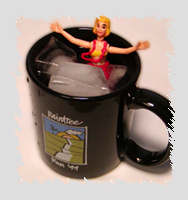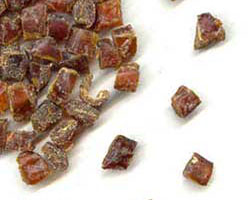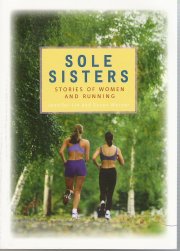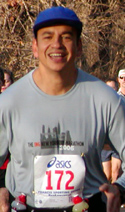 How To Do An Ic-c-c-c-e Bath How To Do An Ic-c-c-c-e Bath
I had frequently heard that an ice bath is a good preventative measure after a long hard run. I recently talked about this with a running friend and he told me about how he always takes an ice bath after his long hard runs and his legs feel much better faster that way. So, I decided I could do that.
The first time, I filled the tub with 6 inches of cold water, dumped in several trays of ice cubes, stripped down and slowly inched my way into the freezing cold. The friend had told me to warn family members that blood‑curdling screams may be coming from the bathroom for a while, but to just ignore them. Well, I did let out a few screeches before the freezing sensation became tolerable.
The next time I ran with this friend, I told him I had taken his advice and taken an ice bath. He then told me that he usually takes a hot drink along to sip while sitting in the tub. OK, I thought, I’ll try that next time. I did take a cup of hot cocoa along the second time and it did help matters somewhat.
I learned on our next run that he also wore a sweatshirt while in the ice bath! I, of course, thought that you had to strip naked to get into a bathtub. So, even the t‑shirt I wore the next time helped the comfort level considerably.
The next time we ran, I confided that it was still extremely difficult to step into that ice water and he then said glibly, “Oh, I get in the water first and then add the ice!” He also informed me that 12 minutes was about as long as he could stand it, while I had been braving it the full recommended 20 minutes.
So, I guess the moral here is to be inquisitive and get the whole story right off. Although, now that I’ve learned all the tricks the hard way, my ice baths now feel more like a luxurious visit to a spa.
Happy Running!
Dee Boeck
more on ice baths | adv: portable ice bath
A Recipe for Runners - High Energy Bar
Try this high energy bar.

- ½ c. sesame seeds and ½ c sunflower seeds
- pinch of salt
- ½ c each of the following: chopped dates, raisins, dried apricots, dried cherries, chocolate chips
- 1c. rolled oats (or quinoa flakes if you’re allergic to gluten)
- 7 c. crisped rice cereal
- 1 c. corn syrup (or honey or brown rice syrup)
- 1 c. sugar
- 1½ c. crunchy peanut butter
- 1 c. powdered milk
- 1 t. vanilla
- ½ t. almond extract
Directions:
Toast the seeds in a medium skillet, stirring constantly.
Add salt and set aside to cool.
Combine the fruit, chips, and sesame seeds and pulse in a food processor until small but not pasty.
Transfer to a large bowl and mix with cereals.
In a small glass bowl, mix the syrup, sugar and peanut butter. Microwave until bubbly.
Stir in the powdered milk, vanilla and extract.
Pour this over the fruit and cereal mixture and mix with wooden spoon until everything is evenly coated.
Press into a greased 10x15 inch jellyroll pan using wet hands.
Cut into squares or rectangles and allow to cool completely before removing from the pan. Wrap individually and toss one in your running bag.
Book Review
Sole Sisters: Stories of Women and Running
by Jennifer Lin and Susan Warner
 This publication is a compilation of 21 separate stories of women’s running. It started with the authors writing an article for the Philadelphia Inquirer about the boom in women’s running. They received so many responses from women runners across the country that they decided to publish a collection of stories they had written. This book was published in 2006. This publication is a compilation of 21 separate stories of women’s running. It started with the authors writing an article for the Philadelphia Inquirer about the boom in women’s running. They received so many responses from women runners across the country that they decided to publish a collection of stories they had written. This book was published in 2006.
Some of the stories could have been written by members of our club; they tell about pre-dawn gatherings under a street light; about sharing child-rearing advice, commiserating over (or celebrating) a divorce, recipe sharing for quick healthy meals, discussions about day-care providers, the best chiropractor or massage therapist, training for and car-pooling to area races, the relative benefits of yoga and Pilates, etc.
Some chapters chronicle the path to Olympic stardom of some elite athletes and others relate the running exploits of “has been” stars, providing support to beginner runner.
There is a story of a junior high school teacher/coach using distance running as a way to keep some of her young charges occupied in a positive, healthful activity and literally keeping them running away from the harmful environment which threatens to engulf them.
One of the most intriguing stories, to me, was that of a Colorado woman who runs with her horses! She runs in between her two horses, holding their reins in her hands. She indicates if there is a particularly tough uphill on their trail, she just jumps on the back of one of the horses - wow - haven’t we all wished for something like that! This story made me ponder what other animal, besides the usual dog, might make a good running companion - an emu perhaps?
There is an inspiring story on the founders of the Moving Comfort brand of women’s running clothing. This clothing did not start out of a huge clothing manufacturer, but out of the living room of a couple of women runners who were not comfortable in the only running clothing available, which were designed for men.
The only other aspect of women's running not covered in this book is that of us baby boomer runners who have been running for 20 or 30 years now and are facing new life challenges. We are seeing our race times slow, we are susceptible to injury and the healing takes longer, and there is a precipitous drop in numbers of those in the 50 and over age groups at races.
Despite that omission, any female runner will find herself smiling, nodding her head or outright laughing as she recalls similar experiences.
I would suggest one person in each running group purchase this book and pass it around.
Review by Dee Boeck
A Runner You Should Know:
Jorge Carvajal
His Thoughts on His First Two Marathons
A bit of background:
 I came to Kansas from Costa Rica in August 2002 to get a PhD. Other than recreational running, swimming and biking I was not really into regular practice of sports. Lack of exercise, hitting the books, visiting Burger King and Chinese and pizza buffets made me gain 40 pounds in 2 years. In the summer of 2005 I joined a KU diet program. My group leader was going to do the sprint triathlon at Lone Star Lake in July that year and I went to watch the event. I made the decision to do that triathlon one year later. By October I had lost 40 pounds but the diet program did not end until March 2006 and the allowed exercise was limited to 150 minutes per week. I came to Kansas from Costa Rica in August 2002 to get a PhD. Other than recreational running, swimming and biking I was not really into regular practice of sports. Lack of exercise, hitting the books, visiting Burger King and Chinese and pizza buffets made me gain 40 pounds in 2 years. In the summer of 2005 I joined a KU diet program. My group leader was going to do the sprint triathlon at Lone Star Lake in July that year and I went to watch the event. I made the decision to do that triathlon one year later. By October I had lost 40 pounds but the diet program did not end until March 2006 and the allowed exercise was limited to 150 minutes per week.
In March I decided I would train for the Olympic version of the Lone Star Lake triathlon (1500 m, 25 miles and 10K). I downloaded a training program and finished the triathlon roughly in 3 hours. I was 4th in my age group. During the training for the triathlon I made another decision: I entered the lottery for the NYC Marathon. In early June I was notified that I won the lottery, continued training for the triathlon and started the Hal Higdon training plan for beginners.
In early August I ran the 10K Crosstown Unity Run in about 47 minutes. I finished 3rd in my age group and the prediction chart for a marathon read 3:38.
Training for NYC:
I heard and read everywhere: for your first marathon do not set a goal time. Your goal should be just to finish it and enjoy it, but being stubborn, I wanted to finish within 3:30:59 in order to qualify for Boston.
I trained four times a week with a day of cross training. I knew nothing about running, including that cement is the hardest for your legs, so I got a calf strain at the end of August that made me turn to the elliptical trainer for a while. After that I stopped running on sidewalks and cement in South Lawrence. I did quite a bit of the midweek training on hills of the KU campus, and I think that made me a stronger runner.
The New York Marathon:
Do you want to miss the cut off for Boston by 5 seconds? Do any of the following.
- At the start pay close attention to the girls dancing New York, New York so that you miss setting your watch at the start line.
- Drop the cap of one your beloved bottles in your belt and turn back to pick it up.
- At the water station at mile 23 walk without needing to.
- In the last .2 miles do not sprint (even if you are strong) and wave to the photographers.
I DID ALL OF THEM!
I ran an average pace of 8:03 and finished in 3:31:04, five seconds short of the Boston cut off. I did not have a watch accurately set (even though I was wearing two watches) and I thought I had missed the cutoff by two or three minutes. I finished 3918th out of 25546 male participants. The race went very well. My slowest five mile split was the first. I think that was one of the reasons for the race going well.
The crowds did not let me start too fast. I had decided to join an 8:00 pace group, but the group was about .5 mile ahead of me for the first 5 miles. By that time, I was able to run with the group until mile 16. I started to feel tired at that point and slowed down. I got separated from the pace group and would not be able to catch them again.
When I got to mile 20 I dug deep inside me, regained strength, and felt as if I was flying. I remember passing a lot of people in the last 6 miles. Although mile 24 and 25 seemed endless, I still was feeling strong. The cheering from the crowds kept me alive in the race, and I finished strong, even though I was not able to understand what this meant until I ran my second marathon.
Running the NYC marathon is a unique experience and the hours of waiting at the starting line are certainly worth it.
Las Vegas Marathon:
My nephew lives in Las Vegas. That meant a lot of savings. The only problem was that the Las Vegas Marathon was only five weeks after New York. Running another marathon this short after my first one did not make sense to anyone except to me.
2007 will probably be my last year in the U.S. and after I go back to my country it will be very costly to come back to run Boston. My dream of running Boston could be fulfilled if I ran another good marathon.
I did some internet searching and read that some runners had accomplished PRs with marathons only five or six weeks apart. They were probably much more experienced runners than me. I figured out a training plan based on some suggestions from the Higdon website, a couple of other websites, and of course after asking several patient runners I have been lucky to know during these months of running.
It turned out that the Las Vegas Marathon was pretty windy and, according to a lot of opinions out in the internet, one of the worst organized, with inaccurate mile markers and lack of gel stations (even though they were scheduled), among other problems.
I also made mistakes that contributed to less than an ideal performance: I found an 8:00 pace group at the beginning of the race and decided (contrary to my planned strategy) that I should be ahead of them and build a cushion so that they would not lose me, as had happened in New York. Fighting the wind and some of the hills in Las Vegas took their toll at about mile 16. I started to feel tired. The 8:00 pace group passed me, and I did not see them any more.
Between mile 16 and 20 I slowed down more than I did in New York. At mile 20 I started to fly, or so I thought, with the only difference being that I ran out of fuel after mile 24.The downhill after mile 20 was another factor that probably killed my legs. In the last two miles I learned what it means not to be able to run. I was just shuffling and hardly made it to the finish. I finished in 3:40.
The Boston Marathon:
Reflecting on the number of meters that 5 seconds means at an 8:00 minute pace, and how this compares with 42000 meters I decided to write to the Boston association, and they accepted me with my NY time.
For Boston I am using Hal Higdon’s Intermediate II training plan as a base. I have three 20 mile long runs scheduled in my training, as opposed to just one that I did for NY. If the weather cooperates in Boston I am planning to shoot for a PR and a BQ between 3:25 and 3:30, and I am hoping to still be able to enjoy the Boston experience.
If I stay longer in the U.S., maybe I would like to taste the world of a half-ironman!
Newsletter
Contributions
All members contribute to the newsletter. Please email articles to: jhuchingson63@hotmail.com. Read past issues on www.runlawrence.org.
About runLawrence
- Janet Huchingson, Historian/Newsletter Editor
Second Wind
16660 21st Street
Lawrence, KS 66044 |